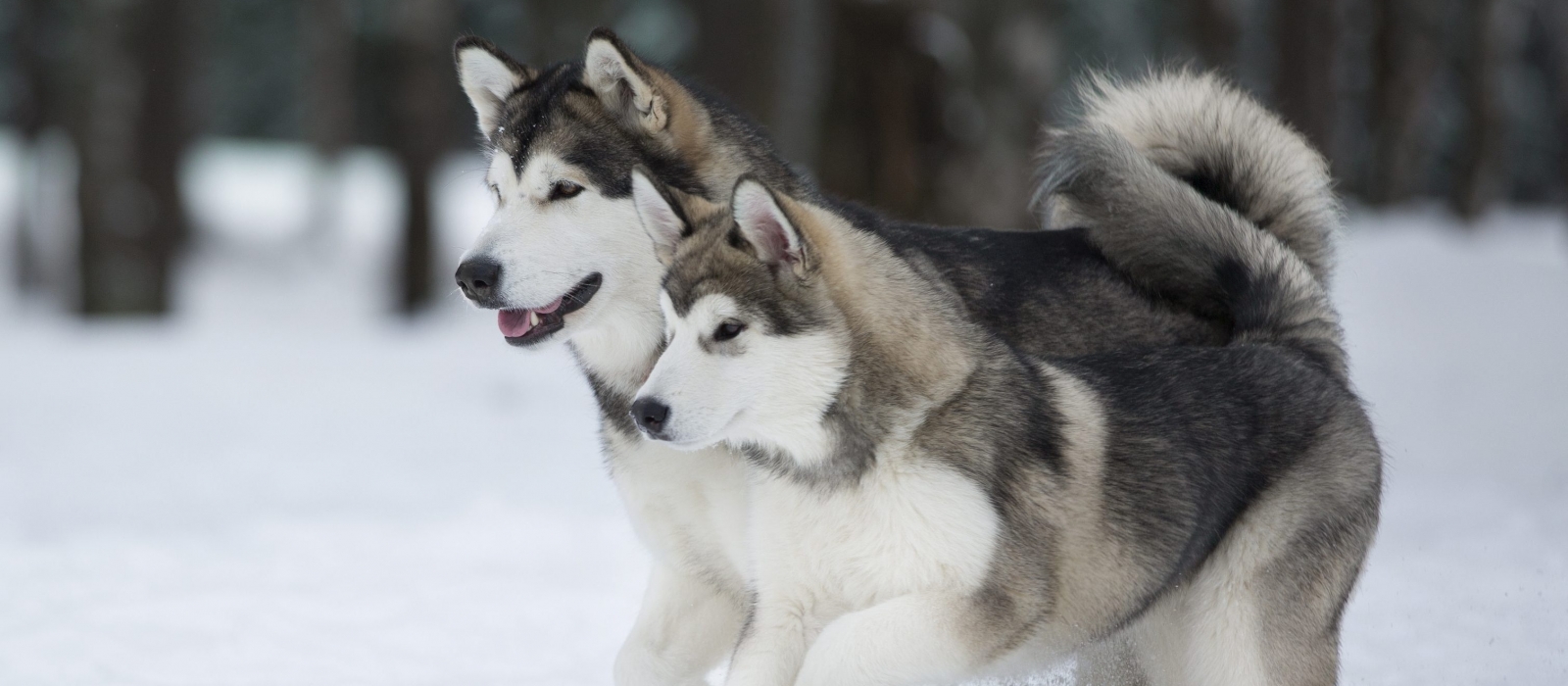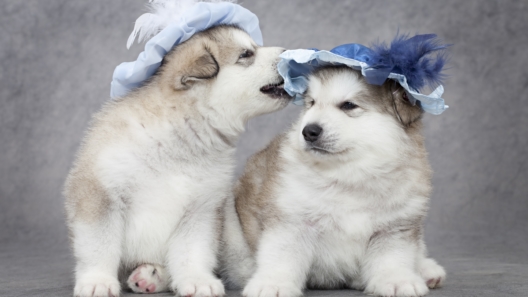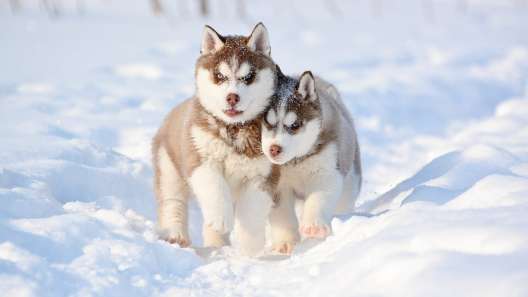-
Activity Level:
high
-
Shedding Level:
high
-
Grooming Level:
high
-
Trainability:
high
-
Good for Novice Owners:
low
-
Adaptability:
moderate
-
Kid/Pet Friendly:
often
-
Prey Drive:
high
-
Watchdog:
very alert
- Average Size: Large
- Average Lifespan: 10-14 years
- Registered?: aca, akc, other
Alaskan Malamute Dog Breed Information
Overview
Temperament
Adaptability
Health
Owner Experience
Grooming
Activity Level
Size
Life Span
Did You Know?
With ancestry relating back to the wolf, the Alaskan Malamute is a striking breed and is the largest of the Arctic sled dogs. Originating in Alaska, the Malamute get their name from the Inuit tribe that settled in the Kotzebue Sound area in northwestern Alaska thousands of years ago, the Mahlemiut, and the sled dogs from which the modern Alaskan Malamute descended.
The Malamute’s brawn and stamina make them ideal freighter sled dogs, built for pulling heavy loads over great distances. Along with Siberian Huskies, the dogs gained popularity during the Gold Rush and expanded into other areas from there. Some Malamutes even joined Admiral Richard Bird on his Antarctic expedition in 1933. The AKC recognized them in 1935 as a member of the Working Group.
Characterized as strong-willed, independent, and very alert, the Alaskan Malamute is an excellent working dog. Their affectionate and playful personalities make them a great family dog. Well-socialized, they get along well with children and other dogs.
They do have a high prey drive, which means they will require extra socialization and training around smaller animals. They tend to do best with animals they have been raised and socialized with. Although Mals can be initially wary and aloof with strangers, they generally tend to be open and friendly and do tend to warm up once introduced provided they have been properly socialized.
One of the facts about Alaskan Malamutes is that they are typically a quiet dog breed in terms of barking, but will bark to alert and are vocal in other ways. Like Siberian Huskies, they will often “talk” to let you know their needs or alert you when something is out of the ordinary. They can become quite vocal and loud dogs if this behavior is encouraged and rewarded a lot when they are puppies.
Due to their size and energy, Alaskan Malamutes may not adapt well to small apartment living since there just is not enough room. However, with proper daily exercise and mental stimulation, they can adapt to more spacious indoor living.
The Malamute is a snow dog breed and absolutely adores cold weather so winter activities are a plus! They are a trusting breed and like to roam. Because they are pack-oriented, they much prefer company rather than spending long periods of time alone.
Potential health concerns to be aware of in Alaskan Malamutes can include hip or elbow dysplasia, inherited polyneuropathy, von Willebrand’s disease, chondrodysplasia (i.e. “dwarfism”), hypothyroidism, luxating patella, day blindness, and thrombopathia. Good breeding practices and the health of the parents make a big difference in the health of Alaskan Malamute puppies.
Reputable breeders will screen their dogs to make sure they are not passing preventable issues to puppies. Make sure you ask the breeder about the health and genetic history of both parents. You can also ask about any health tests or clearances that have been done. The Alaskan Malamute Club of America recommends an Alaskan Malamute Polyneuropathy (AMPN) DNA test, a hip evaluation, and an ophthalmologist evaluation at a minimum.
As a large dog breed, the Alaskan Malamute is at a higher risk for bloat. Bloat in dogs can be dangerous and quickly becomes fatal if gastric torsion occurs (i.e. if the stomach flips). It’s important to know how to reduce the risk and what symptoms mean that it’s time to get to the emergency vet.
To keep your pet healthy, attend regular vet checkups, provide a nourishing diet, and commit to a daily exercise routine. Discuss ailments or possible future ailments with your vet. By deciding on a specific diet plan, you and your veterinarian will help your dog enjoy good health for years to come. Like humans, as your dog matures we also suggest beginning physical therapy and possible brainteasers. This will keep the mind and body sharp while they age.
This energetic dog breed is usually not a good fit for novice dog owners. These large dogs are high-spirited and highly intelligent working dogs. They tend to pick up on commands easily, but they are also one of the most independent dog breeds and can become hardheaded.
An owner who is consistent, patient, firm, and kind with training will earn a Mal’s trust, respect, and devotion. They are sensitive souls, so they will not respond well to harsh commands or corrections. Puppy training classes can help strengthen the bond with your Mal, keep them engaged during training, and help keep training consistent.
They also need a job to do as they can easily become bored. These dogs are working dogs bred for stamina and endurance. They have a lot of energy and a lot of brainpower, so it is important to keep them properly exercised and mentally engaged. Alaskan Malamutes are smart dogs and may make a game of outsmarting you to entertain themselves if they have not gotten enough exercise or if they become bored.
Alaskan Malamutes are one of the fluffiest dog breeds. They have a dense double northern coat, and it is somewhat harsher than the smaller Siberian Husky. The usual colors are various shades of gray and white, sable and white, black and white, red and white, solid white, or even blue and white.
The Malamute will shed year-round and blow their undercoat twice a year. More grooming is needed during this time to prevent matting. Daily brushing is recommended all year long to keep their coats healthy and prevent mats. A pin brush, metal comb, and undercoat rake are good types of dog grooming brushes to have on hand. A grooming glove is a helpful bonus. A bath is recommended every 6 to 8 weeks as needed. If competing in shows, bathing will likely be weekly.
In addition to coat care, you will also need to care for your Alaskan Malamute’s nails, ears, and teeth. Trimming nails once or twice monthly is usually enough to keep them from growing too long. But, you may need to cut your dog’s nails more often if they grow quickly.
Checking ears weekly and carefully cleaning your dog’s ears as needed can help prevent ear infections. Practicing good dental care for dogs can help prevent painful dental diseases later in life. Brushing teeth or using an enzyme toothpaste daily is ideal, along with cleanings at the vet when needed.
The Malamute is one of the most active dog breeds and requires a substantial amount of exercise. Built for heavy work, daily walks and outside play time are a must to keep your dog happy and avoid destructive behaviors.
These pups are athletic. Once they are done growing and are cleared for higher-impact activities, they can adapt to a wide range of activities as a family member such as jogging, swimming, hiking, and, of course, sled/weight-pulling activities.
Alaskan Malamutes love to dig. It cannot be trained out of them because it is instinctive, but you can work to redirect instinctual digging. It’s best to have an area designated for them to dig. You can train them to dig only in that location, saving your flower beds or yard from a digging disaster. This also means any fence around your backyard needs to continue down into the ground so your Mal cannot easily dig under it.
A fully-grown Alaskan Malamute usually stands 23-25 inches tall and weighs 75-85 pounds on average.
Alaskan Malamutes generally live for 10-14 years on average.
A group of schoolchildren started a campaign to recognize the Alaskan Malamute as the official state dog of Alaska. Thanks to their efforts, this dog breed has served as the state dog of Alaska since 2010.









